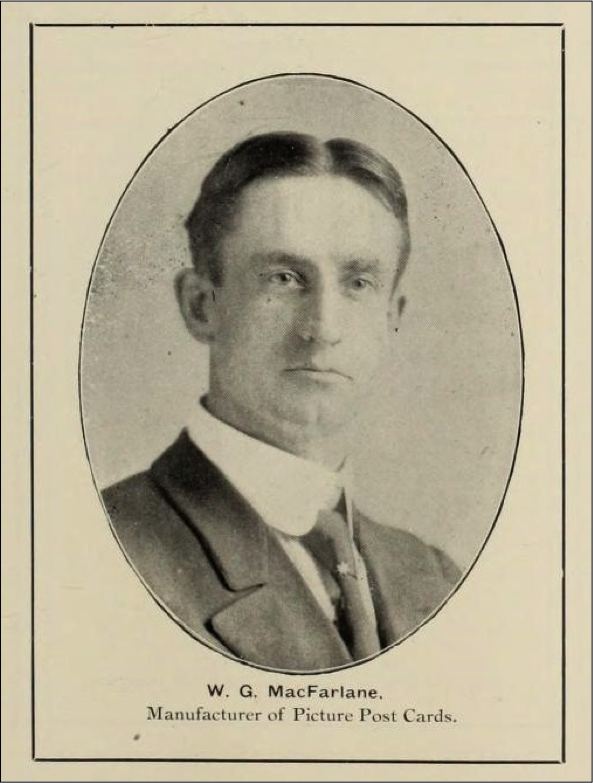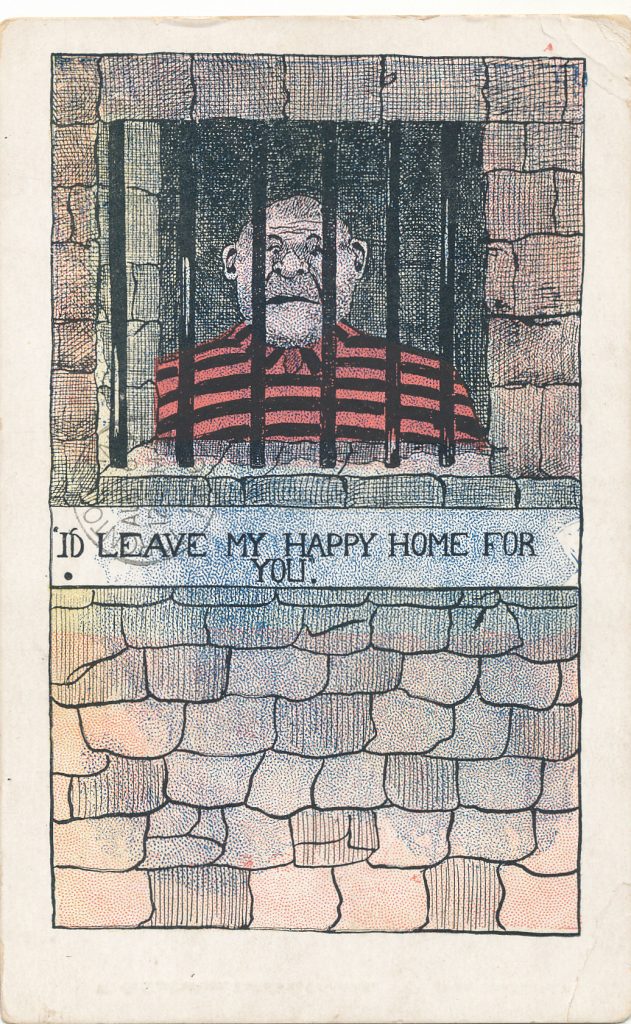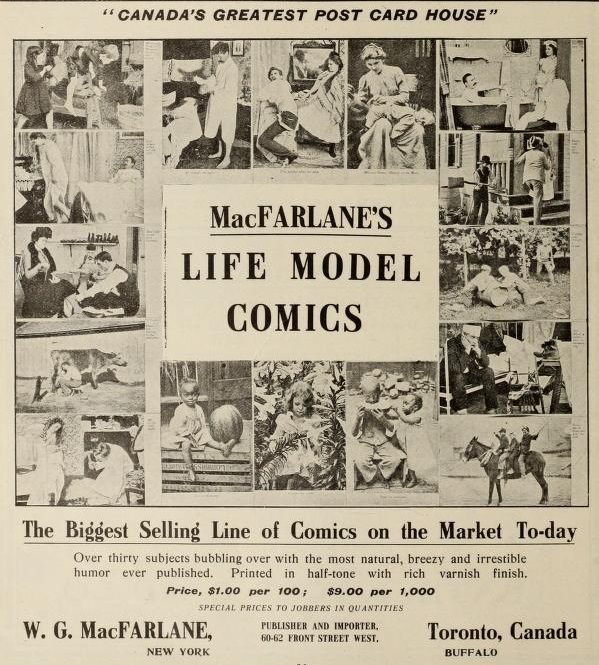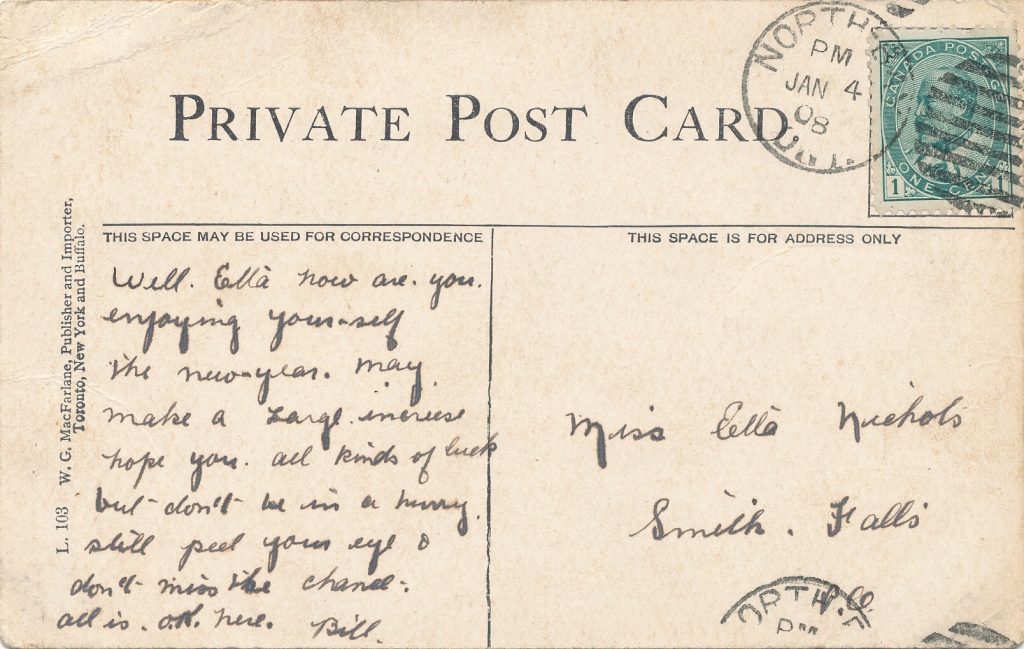Headquartered in Toronto, W. G. MacFarlane was one of Canada’s leading publishers of souvenir view-books and, from 1902 to 1908, was also the ambitious publisher of thousands of postcards . The latter included a number of series of original art cards as well as view cards from nearly every part of Canada and many U.S. states. The MacFarlane company’s rapid rise and sudden collapse were not unusual in the highly competitive business of postcards in the 1900-14 period.
The story of MacFarlane postcards is closely intertwined with the personality and ambitions of the company’s founder. William Godsoe MacFarlane was born 28 December 1870 in Fairville, New Brunswick, now part of the city of Saint John. He was the second child, and only son, of Foster MacFarlane (1834-1899), a physician, and Elizabeth Ann MacFarlane (née Babbitt; 1843-1894). Instead of following in his father’s footsteps, the young MacFarlane became a newspaperman, working for the St. John Sun and joining the Saint John Press Club as a founding member when it was incorporated on 21 April 1894.
Apparently sensing that there was a market in local-interest publications, he authored two such works in 1895:
- New Brunswick bibliography: the books and writers of the province. (Press of the Sun Printing Co., St. John, N.B., 1895)
- Where breezes blow: an illustrated guide to St. John and Fredericton and the province of New Brunswick describing the tourist’ resorts, fishing and bathing waters and the routes of travel of a delightful country. (Mason & MacFarlane, St. John, N.B.,1895)
During this period MacFarlane was also pursuing post-secondary studies. In 1898, he graduated with an M.A. from Acadia University in Wolfville, Nova Scotia. Graduate studies followed in the political science departments of Harvard and Columbia universities. MacFarlane is also said to have worked at newspapers in Port of Spain, Trinidad, and New York City, although it is unclear exactly when (see William Bradford Brown, The Babbitt Family History 1643-1900, published 1912, p. 435).
In what follows, we divide MacFarlane’s life from 1899 onward into periods that are defined by the names of his business enterprises and by the cities in which he lived. We refer to him generally as “William” in order to distinguish him from the various businesses that bore his name.
Grip, Limited, Toronto, 1899
It is suspected that William moved to Toronto in 1899 (or possibly 1900, following his father’s death in Saint John in December 1899). While not confirmed by city directories, an August 1905 article in the Bookseller and Stationer and Fancy Goods Review states that William “about five years ago, in conjunction with Grip, Limited, Toronto, started out to publish cards [post cards] and souvenir books. He assumed all the publishers’ risks, Grip, Limited, taking care of the details of manufacture.” The relationship with Grip, Limited is confirmed by an entry in the 1903 Toronto City Directory that lists W. G. MacFarlane as a publisher in their employ. In the 1901 census, he appears as a lodger at the boarding house of Mary (or “Minnie”) Bailey at 294-296 Jarvis Street, north of Gerrard Street.
Grip, Limited was founded in 1873 by the cartoonist J. W. Bengough (1851-1923) to publish the satirical magazine Grip. After Bengough’s departure from the company and the dropping of the magazine in 1892 the company evolved into an important design firm, providing artwork, wood cuts, and other services for merchandise and print advertising. Among other things, it was responsible for what is generally thought to have been Canada’s first “local view” private postcard, entitled “Beautiful Barrie”, in 1895. In 1899, Grip, Limited was located in the Saturday Night Building, located at 26-28 Adelaide Street West, about halfway between Bay and Yonge Streets. The 6-storey building had an astonishing 24 tenants, ranging from journals such as The Canadian Wheelman to the United States Consulate.
W. G. MacFarlane, Toronto, 1902
After gaining early success with the production of Souvenir View Albums while working for Grip, W. G. MacFarlane began publishing picture postcards in 1902. According to the Toronto Postcard Club’s Michael J. Smith, author of The W. G. MacFarlane Picture Postcard Handbook 1902-1910, the earliest known MacFarlane published postcard was mailed at Yarmouth, Nova Scotia on 16 July 1902.
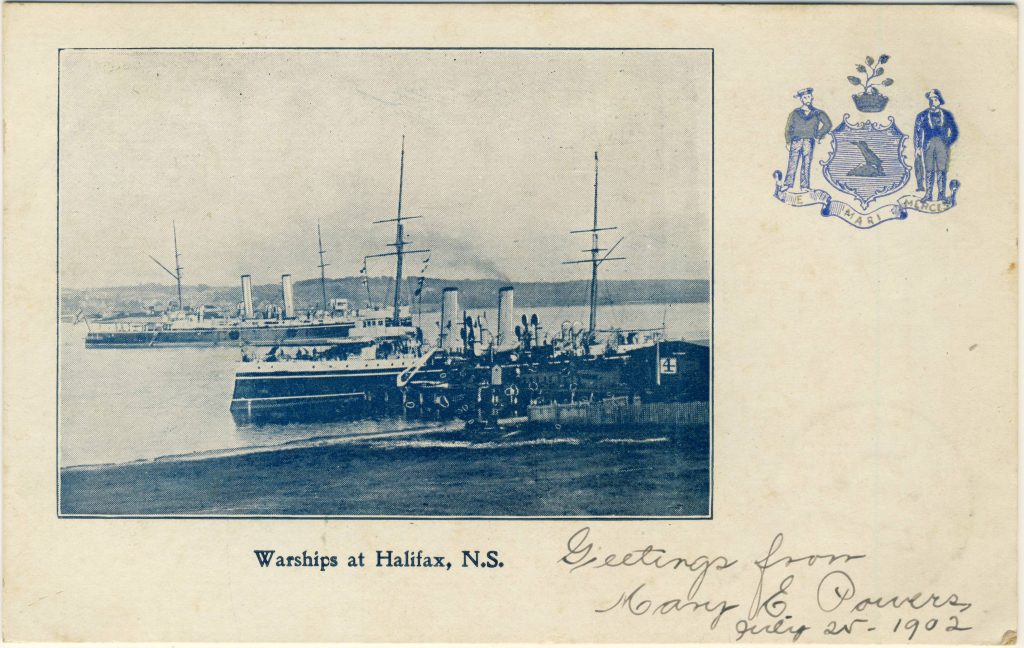
“Warships at Halifax, N.S.”, from what is thought to be the earliest series of MacFarlane “local view” postcards, bearing the coat of arms of the city of Halifax, Nova Scotia.
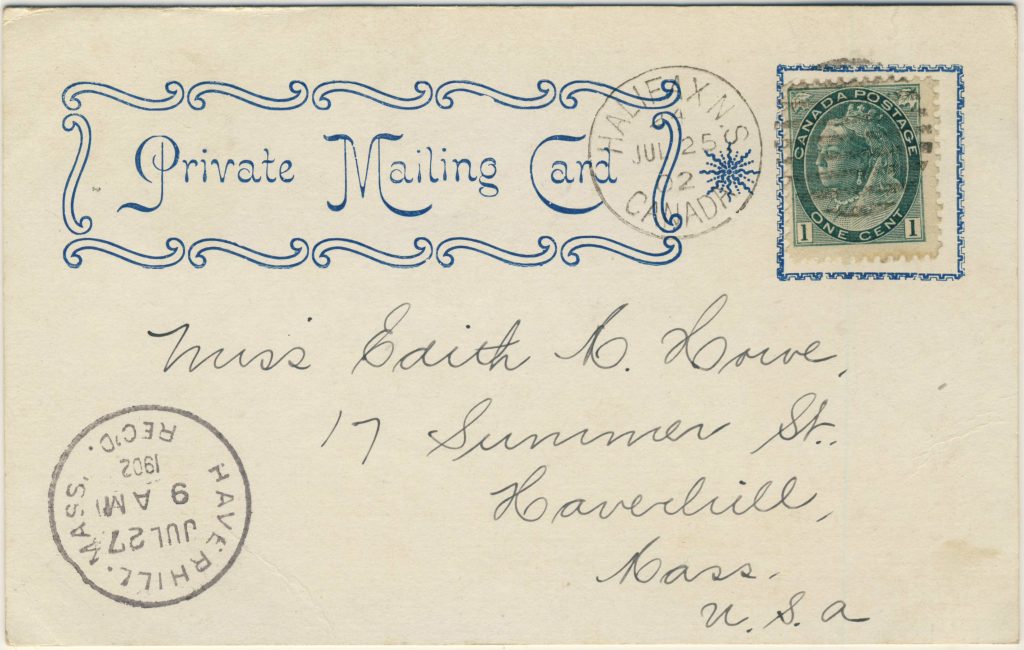
The “Private Mailing Card” back was used on many of the earliest MacFarlane postcards. This example of “Warships at Halifax” was posted on 25 July 1902, barely a week after the earliest known use of a MacFarlane postcard.
Unlike rival Toronto postcard publishers Warwick Bros. & Rutter Limited, Copp, Clark Co. and W. J. Gage & Co., who were devastated in the great Toronto fire of 19 April 1904, W. G. MacFarlane’s business seems to have survived unscathed. In an advertisement placed in the April 1904 edition of Bookseller and Stationer, he announced, “To the Bookseller and Souvenir Dealer: We take this opportunity of advising you that we are fortunate in escaping any loss in the Toronto fire, or curtailment in our facilities for filling orders for SOUVENIR BOOKS OR PICTURE POST CARDS.”
The souvenir view albums published by W. G. MacFarlane while he was employed by Grip, Limited, can frequently be identified by the inclusion of “Saturday Night Building” in the address given for the publisher. A tentative list of albums belonging to this period and for which a title page could be examined, follows:
Scenic Canada Photo Album Series
- Saint John: City and River. (W. G. MacFarlane, [Saturday Night Building] Toronto, n.d.)
- Halifax: The Garrison City. (W. G. MacFarlane, [Saturday Night Building] Toronto, n.d.)
- Railway Series Photo Albums (Expressly for the Canada Railway News Co., Limited)
- The Islands of the Gulf: Cape Breton and Prince Edward. (W. G. MacFarlane, [Saturday Night Building] Toronto, n.d.)
- Through the Evangeline Country to Halifax.
- St. John – City and River.
- Montreal – Historic and Picturesque.
- Toronto: The Ideal Summer City. (W. G. MacFarlane, [Saturday Night Building] Toronto, n.d.)
Other Canadian View Books
- Brockville-on-the St. Lawrence: The Thousand Island City
- 100 Glimpses of Niagara
- Canada’s Scenic Grandeur. [from Photos furnished by the Canadian Pacific Railway and Wm. Notman & Son.] (W. G. MacFarlane, [Saturday Night Building] Toronto, 1901)
- Quebec: The Ancient Capital of a Continent. (W. G. MacFarlane, [Saturday Night Building] Toronto, n.d.)
- Evangeline Land (W. G. MacFarlane, [Saturday Night Building] Toronto, n.d.)
- Picturesque British Columbia: its magnificent mountain and river scenery. The peaks and passes of the Rockies and Selkirks. The weird Fraser Canon and the Kootenay and Crow’s Nest country. The beautiful coast cities of Vancouver and Victoria. (W. G. MacFarlane, [Saturday Night Building] Toronto, n.d.)
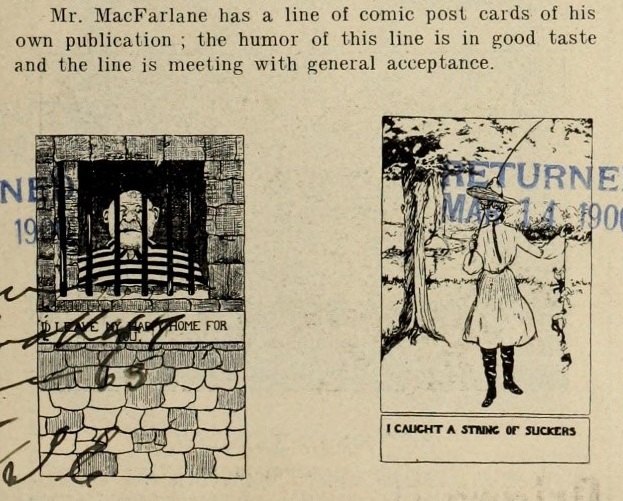
Advertisement for comic postcards (The Bookseller and Stationer and Fancy Goods Review, March 1906, p. 33).
Wm. G. MacFarlane, Toronto, 1905
On 1 February 1905, W. G. MacFarlane, “took the business over from Grip, Limited, and located it in the Westwood building, at 72 Bay street, these premises offering exceptional advantages for offices, sample and warerooms. ” The Westwood Building was located on the west side of Bay Street, one door north of Wellington Street. It was a new five-storey flat-roofed structure and had replaced an earlier building that was destroyed in the Great Toronto Fire of the previous year.
In February, William became the agent for Stewart & Woolf (London) and W. & A. K. Johnston (Edinburgh), for fancy and comic postcards. He could also supply postcard albums, postcard racks, burnt leather postcards, letter cards and a variety of other souvenir novelties.
Concerning travellers: “Mr. Willis E. Hebb (a Halifax businessman and postcard publisher from 1904 to 1914) is representing Mr. MacFarlane in the maritime provinces. Mr. W. S. Rainnie will shortly take out the line covering Ontario towns. Mr. G. L. Smith takes care of the Toronto trade.”
The souvenir view albums published by Wm. G. MacFarlane after leaving Grip, Limited, but before consolidating his Buffalo branch office, can be identified by the abbreviated credit line for the publisher which reads “W. G. MacFarlane Toronto”. A tentative list of these albums follows:
Scenic Canada Photo Album Series
- Fredericton the celestial city and the river St. John: New Brunswick’s fair capital and its handsome architecture, and the glorious scenery of the “Rhine of America,” the thousand mile waterway, the St. John. (W. G. MacFarlane, Toronto, n.d.) for Albright & Cropley Publishers, Fredericton
- The twin towns Port Arthur and Fort William: The magnificent scenic features and the prosperity and progress of the Thunder Bay District of Lake Superior – The haunts of tourists and sportsmen – shown with pen and camera. (W. G. MacFarlane, Toronto, n.d.) for J. L. Meikle, publisher Port Arthur, Can.
Other View Books
- Historic Montreal: Canada’s metropolis, the chief city of the stranger, its places of historic and romantic interest, its magnificent architecture, its parks and squares, seen in summer garb of green and winter’s robe of snow. (W. G. MacFarlane, Toronto, n.d.)
- Mining Camps of British Columbia. (W. G. MacFarlane, Toronto, n.d.)
- View Book of London, Ont. (W. G. MacFarlane, Toronto, n.d.) for S. H. Knox & Co., London, Ontario
- Saint John, 1604-1904. (W. G. MacFarlane, Toronto, n.d.)
Wm. G. MacFarlane, Toronto and Buffalo, 1905
A month or two after re-locating to Bay Street, W. G. MacFarlane decided to open a branch office in Buffalo, N.Y., to take care of his rapidly-growing American business. The office was located at Room 15, Coal and Iron Exchange. Mr. Rae F. Stetson was put in charge. At the same time, a Mr. Little was hired as a traveller to cover western Canada and promote the sale of souvenir books, picture post cards, import fancy and comic post cards, burnt leather novelties, post card albums, and Christmas cards. By August of 1905, Wm. G. MacFarlane could boast that: “The trade of Canada from coast to coast and of a portion of the United States is taken care of by three or four travellers.”
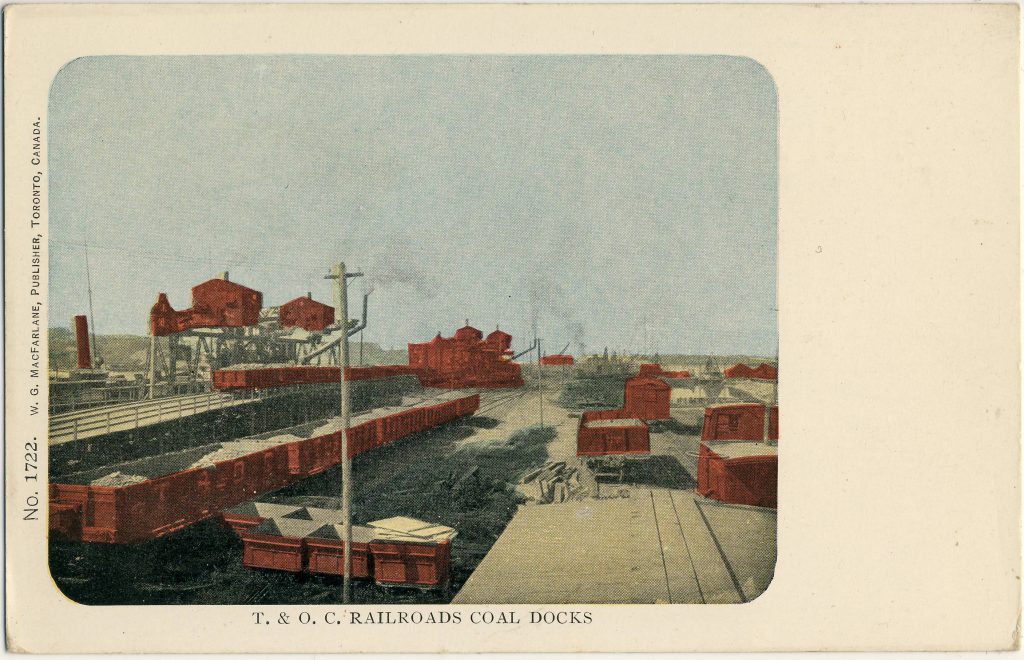
Toledo & Ohio Central Railroad coal docks at Toledo, Ohio. One of the American cards of W. G. MacFarlane, no. 1722. Surprisingly, the publisher credit for this U.S. card refers only to MacFarlane’s Toronto location.
In May 1906, Wm. G. MacFarlane re-located its Toronto office to 60-62 Front Street West, a new concrete, six-storey loft building, about half-way between Bay and York Streets. It was one of the first buildings erected in the aftermath of the April 1904 fire, in which the entire north side of Front Street West, both east and west of Bay, had been completely engulfed in flames and destroyed. MacFarlane was one of the first business tenants, which had grown to 12 by 1907. In June 1906, MacFarlane visited Germany “to secure the most up-to-date ideas in post cards and familiarize himself with foreign markets.”
The first order of postcards in the new Troilene process (tri-colour reproductions from oil paintings) by the artist John Innes, arrived in August, 1906. Other series in Troilene, including those painted by his sister Sara Wendell (MacFarlane) Mitchell (see below), would follow.
Following the opening of the Buffalo branch office, and before incorporation, William authored a number of souvenir view albums. They can be identified by the modified credit line for the publisher which reads “W. G. MacFarlane, Toronto and Buffalo” or “W. G. MacFarlane, 60-62 Front St. W.”. A sample of view books of this period follows:
View Books
-
-
- Victoria British Columbia: The fair coast capital. Famous as a summer resort on account of its delightful summer climate. The prettiest city on the north Pacific coast. Magnificent parliament buildings, splendid business streets and beautiful homes. (W. G. MacFarlane, [60-62 Front St. W.] Toronto, n.d.)
- Winnipeg, metropolis of the west: A series of views illustrating the Chicago of Canada, as it appears to-day: Showing its most recent architecture, including the Union Bank, C. P. R. Depot, Carnegie Library, etc., etc,: Views also of its parks, its churches, its schools and other points of interest. (W. G. MacFarlane, Toronto Can. & Buffalo N.Y., n.d.)
- Photographic View Album of Brandon Manitoba. (W. G. MacFarlane, Toronto and Buffalo, n.d.) for D. E. Clement, Brandon.
- Indian Head, Saskatchewan: The largest initial wheat shipping point on the face of the globe – situated on the main line of the C. P. R. – Electric lighting, local and long distance telephone system and waterworks are being introduced. A town of pretty gardens and handsome homes. (W. G. MacFarlane, Toronto and Buffalo, n.d.) for The Prairie Witness, Indian Head.
- Picturesque and Scenic Beauties of The Columbia River and the Metropolis of the Pacific Northwest. (W. G. MacFarlane, Toronto Canada and Buffalo N.Y., n.d.)
- Beautiful Bellingham [Washington]
- Detroit the Beautiful (W. G. Macfarlane, 1910)
- Quaint old Charleston, America’s most historic city [its homes, gateways, historic landmarks, and distinctive architecture]
- The Charms of New Orleans
- Views of Duluth, Minn.
Note: The U.S. titles listed immediately above were reportedly published by W. G. Macfarlane, according to online sources. While we know of no reason to doubt these attributions, we have not seen actual copies of the publications. We are also unsure about most of their publication dates but think it likely that they were produced in this period.
Wm. G. MacFarlane, Toronto, New York and Buffalo, 1907
In March 1907, it was announced that the U.S. headquarters of W. G. MacFarlane would be moving from Buffalo to New York City. The obvious advantages of such a location, according to a writer in Bookseller and Stationer and Canadian Newsdealer (March 1907), were that New York was the centre of art in America, the home of top-notch engraving and the importing centre for high-class German postcards.
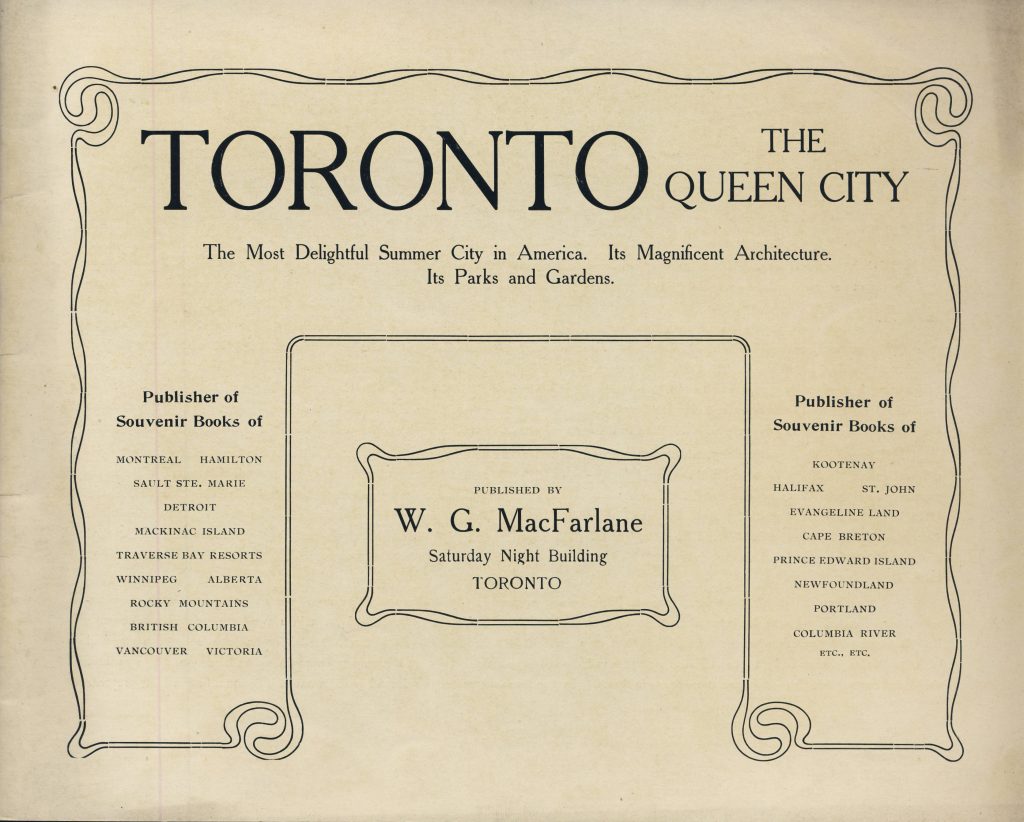
Title page of undated MacFarlane viewbook entitled Toronto, The Queen City. Note the long list of other viewbooks in the series.
The MacFarlane Company, Toronto and New York, 1907
In December 1907, it was announced that the business conducted by W. G. MacFarlane was now federally incorporated and would operate under the name of The MacFarlane Company. The corporation (company) had generally the same rights and obligations under Canadian law as a natural person but offered a number of benefits including the creation of a separate legal entity, limited liability, lower corporate tax rates, better access to capital and a continuous existence. To William, the most obvious benefit would have been the lower tax rate.
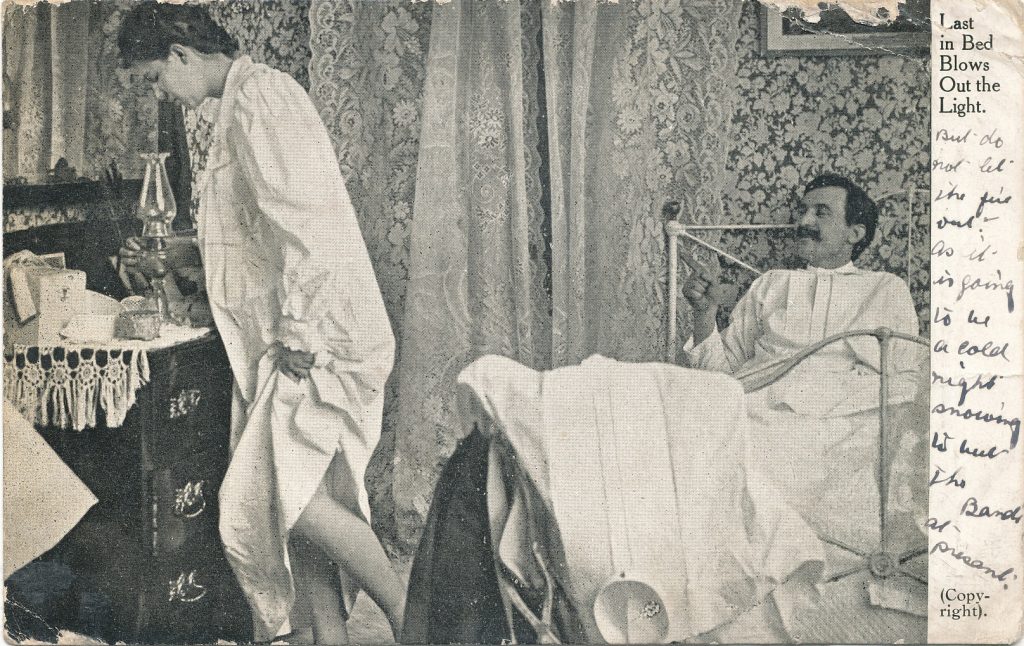
“Last in Bed Blows Out the Light.” – L. 103 – W. G. MacFarlane, Publisher and Importer, Toronto, New York and Buffalo.
Failure of the MacFarlane Company, 1908-09
In January 1908, B. G. Newton, manager of the Canadian office of The MacFarlane Company, severed his connection with that firm to accept a position with the Home Monthly Publishing Co. of Brantford, Ontario. In hindsight, it was the first sign of impending financial difficulties with The MacFarlane Company. It is likely that the Company filed for bankruptcy in April 1908. On 8 May 1908, a meeting of the creditors of the Company was held at the office of the assignee, James Hardy, of Jenkins & Hardy, Toronto. The statement presented showed assets of $24,070.41 as against liabilities of $20,103.44: a nominal surplus of $3,966.97. Inspectors were appointed and the trustee was instructed to wind up the estate under their direction. A separate bankruptcy proceeding was commenced before the U.S. District Court for the Southern District of New York, in which MacFarlane listed no assets other than the worthless shares of his company. The proceeding was reported in the 13 November 1909 edition of The New York Times (p. 17).
The stock belonging to the estate of W. G. MacFarlane, valued at $2,800.00, was sold at auction by Suckling & Co. The view books of Canadian cities were purchased en bloc by the publishers McLeod & Allen.
By December 1908, a full list of the amounts owed to the firm’s creditors had been prepared. It reveals the names of the many foreign printers who were used by W. G. MacFarlane. The largest creditors, with their respective claims, were:
Germany
- P. Finkenrath, Berlin, $1,994.50;
- Carl Garte, Leipzig, $5,662.36;
- Gebruder Humar, Munich, $1,762.54;
- H. F Jutte, Leipzig, $3,951.20;
- Sinsel & Co., Leipzig, $7,671.43;
- Stengel & Co., Dresden, $1,500.00.
Great Britain
- Willesden Lithographic Co., Limited, London, Eng. $3,320.49;
- Miller & Lang, Glasgow, $315.47.
U.S.A.
- Alling & Cory, Buffalo, $514.28;
- Art Lithographic Pub. Co., New York, $1,316.32;
- German-American Post Card Co., New York; $824.55;
- Katch & Sommerich, New York, $1010.90.
A short article in The New York Times described MacFarlane’s situation, and referring to his New York office at 29 W 33rd Street, contains a similar list, with some omissions and the addition of the reference to Stengel & Co., as noted. (see “Business Troubles”, The New York Times, 23 July 1909, p. 9). (See The Postcard Album for detailed information on German postcard printers and publishers.)
Another article, “Small Dividend to MacFarlane Creditors,” which appeared in Bookseller and Stationer and Canadian Newsdealer‘s December 1908 edition, provides a rare analysis of the MacFarlane Company failure:
The failure of the MacFarlane Company is attributed to an over-extension of business which a failing market and lack of sufficient capital did not warrant. The Canadian branch of the business was doing well, but an attempt to cover the United States field under the unpropitious circumstances that occurred last year proved too much and a failure was the result.
The “failing market” and the peaking of the postcard craze, is dealt with by a number of writers. Orville C. Walden (1879-1958) writing in Post Card Enthusiast (September 1951) states:
In 1907 the United States imported from Germany 32,795 tons of picture post cards. In 1908, 25,902 tons and in 1909, 27,769 tons. British trade journals stated that the post card fad was at its zenith in 1908, and since that time, sales steadily decreased.
An article which appeared in many North American newspapers, including The Evening Journal, Ottawa (4 January 1909), reinforces this observation:
POSTCARD CRAZE IS DYING.
German Manufacturers Report an Enormous Falling Off in America.
Berlin, Jan. 4. – German manufacturers of souvenir postcards held a meeting in Berlin this week to consider the state of the trade, which it was agreed was going from bad to worse. The consensus of opinion among the long-faced delegates was that the slump, in the postcard craze in the United States was the chief cause of their troubles.
One or two years ago cards made in Germany were shipped to America literally by the million. Nowadays, the manufacturers state, they rejoice if they can get orders for as many thousands.
The meeting came to the lugubrious conclusion that the postcard industry had seen its best days. The hope was expressed that people would soon take up another fad which would bring as rich profits as the postcards had.
Contributing to the decline was the anticipation by jobbers to the probable implementation, in the United States, of the Payne-Aldrich Act on August 5, 1909, which would impose higher customs tariffs on a broad range of imported postcards. George and Dorothy Miller, in Picture Postcards in the United States 1893-1918, describe the impact on the trade thus:
Jobbers and importers, however anticipating the tariff, made a concerted effort to stockpile German cards. Every link in the chain was overloaded: importers overloaded jobbers, jobbers overstocked retailers, and according to Orville Walden, “every card rack in the country was loaded.” Most retailers were faced with a year’s supply of cards. In an effort to move stock, price cutting began: cards which sold two for five cents became three for five, then a cent each, six for five cents, and even ten for five cents. Without fresh stock, dealers began to lose interest and turned to more profitable lines.
Not one to give up, in December 1908 William announced the founding of a new magazine in Toronto, national in scope, with Canadian writers and artists and similar in format to Appleton’s and McClure’s. It does not appear to have got off the ground.
Edwards & Deutsch Lithographing Co., Chicago c. 1911-1922
Brief marriage to an heiress
William’s movements after 1908 are more difficult to trace. He first appears in The Lakeside Annual Directory of the City of Chicago 1911, living in a house at 5642 Washington Avenue in that city. He married Mary H. (Harahan) Nicol (1872-1934) on 23 November 1912 in Cleveland, Ohio. Mary was a wealthy heiress who at the time enjoyed a $30,000 annual income from a legacy left to her by her father, the late James Harahan, president of the Illinois Central Railroad. At the time, William was said to be a “Lithographic Business Manager” and a resident of Chicago. We learn from The Babbit Family History, which was published in 1912, that William was then with Edwards & Deutsch Lithographing Co., located at 2320-2332 South Wabash Avenue in Chicago. They were a well-known Chicago firm dating back to 1896. Besides their colour commercial and offset lithography, Edwards & Deutsch also produced booklets, car-cards, cut-outs, folders, hangers, labels, offset posters, window displays etc. They are best remembered today for their World War One-era propaganda posters.
Mary had a daughter from one of her two previous marriages, but there do not appear to have been any additions to the family during her brief union with W. G. MacFarlane, which ended in divorce. According to her testimony in court, Mary tired of paying for William’s life of travel: in the summer of 1915, matters came to a boil, as she demanded that he do more to support her. According to her testimony, his response was to walk out on her, never to return. Having thus established the required element of desertion, Mary was granted a divorce — her second — in November 1915. The proceedings attracted considerable attention in the Chicago area: a front-page story, The Chicago Tribune described William as “a poor young salesman”, although in fact he was 45 and from a well-to-do family. In any event, by the time of the 1920 census, William was once again in lodgings, this time at 5479 Dorchester Avenue in the Hyde Park neighbourhood of Chicago. (see “Mrs. James T. Harahan’s Daughter Gets Divorce”, The Chicago Tribune, 17 November 1915, p. 1)
A view book from this period
An example of a souvenir view album, authored by W. G. MacFarlane while he was with the Edwards & Deutsch Lithographing Co., follows:
Private Patients’ Building and Nurses’ Home, Toronto General Hospital. (Grip, Ltd. [for W. G. MacFarlane Ltd.], Toronto, 1913)
The American Autochrome Co., Chicago and Toronto c. 1922-1938
William’s later involvement with The American Autochrome Co. is confirmed by the souvenir view album XXVIII International Eucharistic Congress, Chicago, June 20-24, 1926, compiled by him and published by the American Autochrome Co. There is also correspondence between Noah Hamilton Rose, a professional photographer and W. G. MacFarlane, representing The American Autochrome Co., concerning picture orders in 1935 and 1936. His ongoing success in the industry may also be inferred from a reference to him as a “prominent Chicago publisher” in the obituary of a relative in a West Virginia newspaper in 1931. (see “Mrs. M’Farlane, Virginia Side, Dies”, Bluefield Daily Telegraph, 29 May 1931, p. 2)
The American Autochrome Co. was located at 300 West Grand Avenue in Chicago and published both postcards and souvenir view albums. A white-border postcard of the New Prudden Building in Lansing, Michigan, published by the Company, has been seen with a July 28, 1922 postmark. The earliest example of a souvenir view album published by the Company known to us is the Telephoto Book of Santa Barbara Earthquake June 29th, 1925: 13 killed, 65 injured, property loss, $15,000,000, published the same year. The Company was still in existence at the time of the New York World’s Fair 1939-40.
American Autochrome view books
A sample of souvenir view albums, authored by W. G. MacFarlane while he was with the American Autochrome Co. follows:
- Historic Montreal: Montreal, Metropolis of Canada, fifth city on the American Continent and second city in the British Colonies. One of the world’s leading ports, headquarters of the two largest railway systems in the world and the eastern terminus of the worlds greatest inland water route. (American Autochrome Co., Toronto, n.d.)
- XXVIII International Eucharistic Congress, Chicago, June 20-24, 1926: pictorial album [comp. by W. G. MacFarlane] (American Autochrome Co., Chicago, 1926)
- Canada Ocean to Ocean: Views of historic places, outstanding architectural features and the wonderful scenery of river, lake and mountain. A pictorial survey of the land of the twentieth century (American Autochrome Co., Toronto, n.d.)
- The charms of New Orleans: the Vieux Carre, the Mardi Gras, the color and romance of French and Spanish days. [comp. by W. G. MacFarlane] (American Autochrome Co., Chicago, 1928?)
- MacFarlane’s “New-System” Street Guide of Toronto. [Copyrighted 1926 by W. G. MacFarlane] (American Autochrome Co., Toronto, 1926)
Canadian Lithochrome Co., Toronto c. 1938-1942
Return to Toronto, late 1930s?
After at least 30 years in the United States, W. G. MacFarlane (or his namesake) reappeared in Toronto in 1941. Might’s Toronto City Directory for that year has the entry “MacFarlane, W G prof r 295 Jarvis”. Located half a block from the rooming house he’d lived in back in 1901, 295 Jarvis was actually the Westminster Hotel (also known as the Inglewood), established in 1890 and still in operation as a long-term-stay hotel as recently as 2018 (but since demolished). As interesting as that is, the 1942 directory has an even more surprising entry: “MacFarlane, W G pres Candn Lithochrome Co r 240 Jarvis.” Based on postally used examples of Canadian Lithochrome Co. postcards, the company was established in 1938. Whether William G. MacFarlane was instrumental in its establishment has yet to be established. The similarity of “The American Autochrome Co.” and “Canadian Lithochrome Co.” names may be more than coincidental. The company was active in 1945 but did not appear in the Toronto city directory after that.
Death in Miami, 1942
On 14 February 1942, William Godsoe MacFarlane died in Miami, Florida, after taking ill toward the end of what, on entering the U.S. on 26 November 1941, he had described as a 3-month winter vacation (he stayed at Miami’s Kentucky Home, also known as the Anderson Hotel). Oddly, the death notice in The Miami Daily News described him as a “retired mining engineer”, an error that might be attributed to the fact that the newspaper was likely relying on a report from a hospital rather than on information submitted by family or friends of MacFarlane. That the MacFarlane who died in Miami was indeed William Godsoe is supported by the fact that the article gave his age (correctly) as 71, as well as by the corroborating information in the 1941 border-crossing record at Buffalo, N.Y.* According to the report, his remains were to be returned to Toronto for burial. (The Miami Daily News, 16 February 1942, p. 8)
-
- *His closest Canadian relative was stated in the border-crossing record to be his nephew, Roydon MacFarlane Barbour (1896-1970). Roydon was a son of his sister Bessie and advertising manager of Saturday Night magazine, Toronto.
Sara Wendell (MacFarlane) Mitchell (1883-1960): A Note
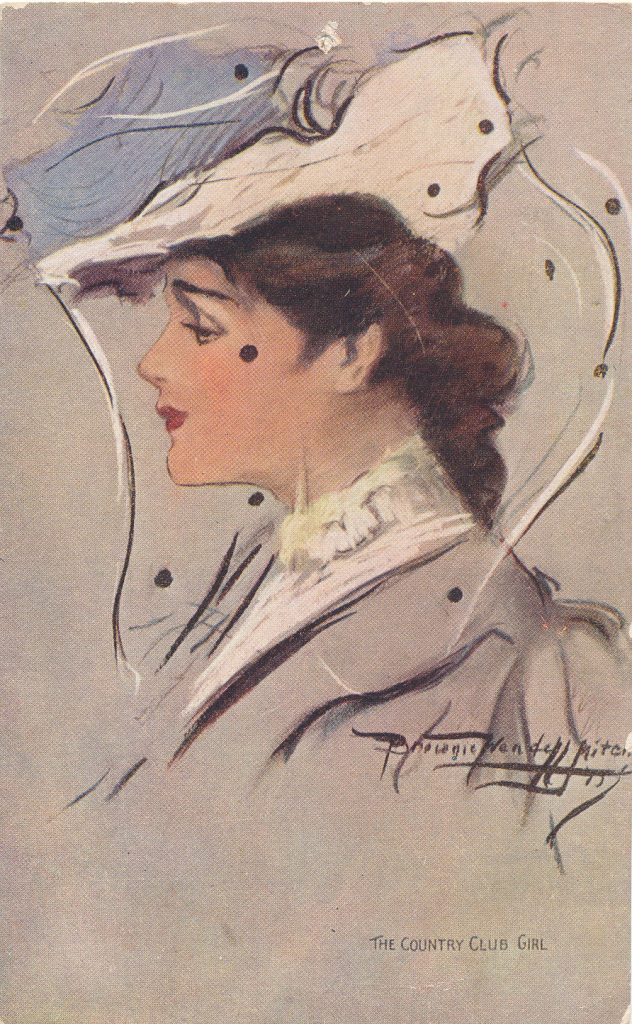
“The Country Club Girl”, from the “Troilene” American Girl Series, Signed “Brownie Wendell Mitchell”, a.k.a. the former Sarah MacFarlane, sister of W. G. MacFarlane. Note on Sara Wendell (MacFarlane) Campbell
In preparing this sketch of the publisher W. G. MacFarlane, the author stumbled on the information that the commercial artist and illustrator Sara Wendell MacFarlane, whose artwork appears on many MacFarlane postcards, was a sister of William Godsoe MacFarlane. She was born in Saint John, New Brunswick on 25 November 1883 and went to New York City in 1906. She studied at the Erie Pope School in Boston and at the Chase School in New York City. She was known particularly for children’s portraits, and also illustrated children’s books. She exhibited at the Art Director’s Club, the Society of Illustrators and the National Academy of Design. She also did artwork for Scribner’s and McCall’s magazines, and for a number of commercial accounts.
The confusion in identifying the artist of the postcards comes from the various signatures she used. She married George Harold Mitchell (1880-1951), an artist from New York City, on 3 October 1904 in Toronto and the following year adopted the signatures “Sadie Wendell Mitchell” or “Brownie Wendell Mitchell” (See Series 38-43 in Michael Smith’s MacFarlane handbook). She divorced George Mitchell in May 1920 and re-married to Ontario-born securities broker Adam Sanford Campbell in 1925. The couple resided in Manhattan. Adam Campbell died on 24 November 1951 and Sara Wendell Campbell on 16 March 1960, each in New York City.
Table of References
- New York Times, 18 March 1960, p. 25. [Obituary of Sarah [Sara] W. Campbell]
- Smith, Michael J., The W. G. MacFarlane Picture Postcard Handbook 1902-1910 [second edition], (Toronto: Michael J. Smith, 2010).
- “W. G. MacFarlane”, Metro Postcard List of Postcard Publishers. [online reference via Archive.org]
By Ken L. Elder, 22 June 2019
with contributions from Andrew Cunningham

